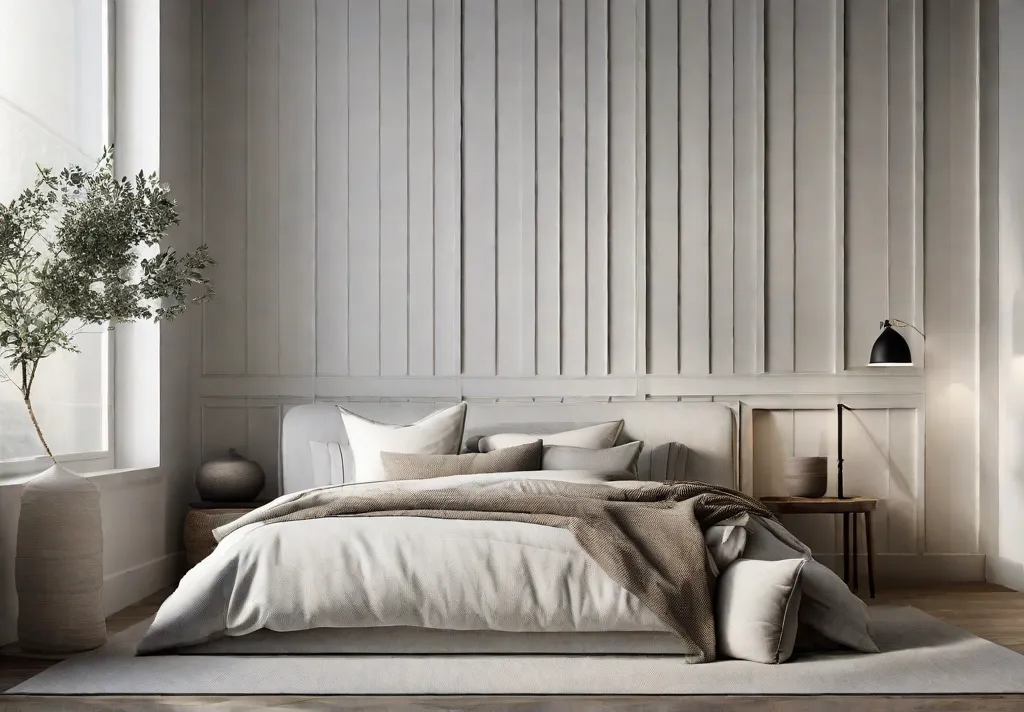As an artistic home decorator immersed in Portland’s culture of sustainability and craftsmanship, I’m always seeking ways to create beautiful yet functional living spaces for my clients. Lately, I’ve been increasingly drawn to the principles of minimalism, with its emphasis on simplicity, decluttering, and purposeful living.
When applied thoughtfully, minimalism can transform living spaces into havens of tranquility that nourish the body, mind, and soul. This is especially true for bedrooms, the most personal spaces for rest and rejuvenation.
The Life-Changing Magic of a Minimalist Bedroom
“Simplicity is the ultimate sophistication,” declared iconic designer Leonardo da Vinci. This timeless wisdom sparked a personal awakening for me. As I gazed around my bedroom, cluttered with one too many throw pillows, stacks of interior design magazines, and half-finished DIY projects, I longed for space, airiness, and simplicity.

At that moment, I knew a minimalist makeover was in order. But what would that entail? How could I balance my artistic leanings with a minimalist aesthetic? This article details my journey towards creating a personal sanctuary that filled me with a sense of zen.
The Path to Enlightenment: 9 Minimalist Makeover Strategies
After much reading and research into minimalist philosophy, I uncovered nine key strategies to create a bedroom oasis:
Decluttering: The First Step to Minimalism
“Have nothing in your house that you don’t know to be useful or believe to be beautiful,” advised 19th-century writer William Morris. With this mantra in mind, I embarked on what felt like an archeological dig of my belongings.
This initial purging brought not just physical but also mental clarity. The piles of tattered magazines, unused craft supplies, and mix-matched solitary pillows went out. In their place, they stood on clean surfaces and empty spaces, waiting to be filled with purposeful items.

Through this process, I learned decluttering is not a one-time endeavor but an ongoing practice. I regularly review my possessions using the “one-year rule”: I donate it if I haven’t used an item in the past year.
Choosing a Neutral Color Palette
Color profoundly impacts mood and emotions. After reading psychological studies on color, I opted for a soothing blend of white, beige, and pale blue – colors associated with clarity, relaxation, and serenity.
To add depth, I brought in layers of natural textures like cotton linens, woven wool blankets, and rattan storage baskets. The result is a space that is both calming and quietly elegant.
Investing in Quality Over Quantity
As a designer, I’ve seen cheap furniture come and go with the passing trends. Minimalism taught me the value of investing in better-made foundation pieces that withstand time.
I splurged on a custom-made bed frame and mattress for optimal comfort. In the corner, an antique armoire handed down from my grandmother adds a touch of history while providing ample clothing storage. These cherished items spark joy whenever I see them.

Maximizing Natural Light
Portland enjoys over 155 rainy days yearly, making sunlight a precious commodity! To remedy my previously dark bedroom, I installed insulating cellular shades that temper the light while providing privacy. For additional brightness, a large mirror reflects light from the windows.
I’m amazed at how these simple changes make the room airy and spacious, even on the gloomiest days.
Smart Storage Solutions
To keep surfaces clutter-free, I incorporated storage furniture like a bed bench with hidden compartments at the foot of the bed. I also mounted floating shelves, which added vertical storage without overwhelming the room.
My favorite organizing trick? Vacuum storage bags that compress bulky off-season items into compact bundles.

Adding Greenery
In line with Portland’s eco-conscious culture, I brought nature inside with low-maintenance houseplants like succulents, spider plants, and air-purifying peace lilies.
I placed small potted plants on the windowsill and mounted floating shelves to display my budding indoor garden. Listening to the soft patter of rain against the windows while gazing at lush greenery fills me with indescribable joy.
Embracing Minimalist Art and Decor
I adored the soothing gray-blue walls with modern geometric artwork in black and white – colors that complement the space while making the art pop. A vase of fresh-cut flowers adds a seasonal touch to an antique console.
The room maintains its peaceful essence by keeping the decor simple and purposeful. The few standout pieces also command more attention compared to a cluttered space.
Focusing on Textures and Materials
While embracing simplicity, I still wanted to create a multi-sensory space. The soft textures of cotton, linen, and wool add tactile comfort, while the smooth glass surfaces of the bedside lamps impart sleekness.

I also incorporated natural elements like wood, rattan, and stone for warmth and depth. The creative blend of materials makes this minimalist space inviting and still uniquely me.
Creating a Focal Point
A cozy vintage armchair with a hand-knitted throw takes center stage in one corner of the bedroom. This little nook by the window provides a quiet spot for reading, journaling, or watching the falling rain – my new favorite mindfulness practice.
This vignette establishes a focal point while the neutral backdrop of the rest of the room prevents it from feeling cluttered or overwhelming.
The Joy of Subtraction: Embracing Simplicity, Harvesting Happiness
The quest for less continues to be deeply personal and rewarding. By consciously decluttering and building my space back up with purposeful pieces, I gained a bedroom and sanctuary.

Beyond the physical space, minimalism cleared my mind of clutter, allowing me to focus on passions and relationships. It restored a sense of harmony and control amidst life’s chaos.
As legendary architect Mies van der Rohe said, “Less is more.” This modest yet profound philosophy continues to guide me as I move through interior spaces and life.
While the tenets of minimalism remain constant, I’m still creatively building and evolving my oasis. I leave you with an open invitation to stop by anytime after you’ve decluttered your sacred spaces!
Frequently Asked Questions
Q: How do I practice minimalism with a family or roommates who aren’t on board?
A: Start with areas that are just “yours,” like a bedroom, closet, or office space. Lead by example to show how decluttering and organization can make home life more manageable. Over time, minimalism can spread through a household. But ultimately, you can only control your belongings and habits.
Q: I need help parting with sentimental items. What should I do?
A: Be compassionate with yourself during this process. For highly sentimental items, consider keeping a few that spark the most joy or memories, then take photos of the rest before donating. This can provide closure while still minimizing clutter.
Q: How often should I declutter to stay on track with minimalism?
A: Aim to do a major decluttering session once or twice per year. Then, practice mini-declutters monthly by sorting through your closet, paperwork, or kitchen drawers to maintain organization. Daily tidying habits also keep clutter at bay.
I hope you’ve enjoyed this glimpse into my journey towards a minimalist bedroom and life. What tips resonated most, and what questions do you have? Let’s keep the conversation going in the comments below!










